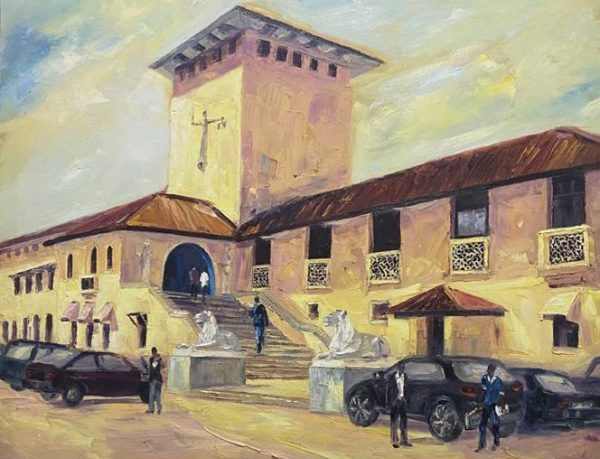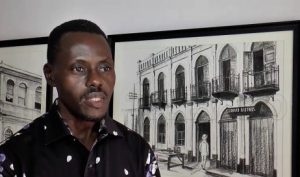Entertainment
#EndSARS: Artist who painted historic Lagos court wants building restored to old glory

BY KAZIE UKO
Some of the ugly fallouts of the recent #EndSARS nationwide protest were the massive vandalisation, looting and destruction of private and public assets and infrastructures, by hoodlums who took advantage of the peaceful protest spearheaded by aggrieved Nigerian youths, calling for an end to police brutality.
What started off as Twitter trend with the hashtag, #EndSARS, to protest series of allegations bordering on extra-judicial killings, human rights violations and high-handedness of the operatives of the now disbanded Special Anti-Robbery Squad (SARS), soon blossomed into full-fledged national protest with a five-point demand on the federal government, hinged on compensation to families and victims of SARS and total reformation of the nation’s police force.
The protest was like none before it. It was not called by any political group, organised labour, civil society or the usually rented rag-tag assemblage. This was unique and sophisticated and it was clear in the manner the protesters organised themselves, presented and projected their demands, even without formal leadership structure.
From Lagos, through the south west states to Abuja, the north central states, down to the entire south east and south-south states of the federation, the battle cry was the same, ‘End SARS’, ‘End Police Brutality’. And for upwards of 10 days, the federal government caved under pressure as it desperately moved to meet the demands.
But what had been a peaceful protest, led by mostly known faces as many of the front-liners were either music or movie stars, soon took a violent turn. Hooligans who had attempted to disrupt the protests at various times by attacking peaceful protesters, without let by security agencies, eventually hijacked the protest and unleashed mayhem on the nation. The situation was compounded in part when armed soldiers were deployed to the streets to help restore order.
READ: Ben Enwonwu’s painting, ‘Tutu’, sold for £1.1 million at London auction
Lagos, the Centre of Excellence, was the worst hit while the looting, carnage and arson lasted. Public buildings and infrastructures; private properties and businesses were vandalised, looted and burnt down and of course precious lives – civilians and security personnel – were sadly lost.
One of the public assets that was vandalised and burnt down in Lagos was the oldest court building in Nigeria, which once housed the nation’s Supreme Court. The Lagos Supreme Court at Igbosere had its existence dated back to the period of the cession of Lagos to the British Government as a colony. It became Lagos High Court at the creation of the Federal Supreme Court.
A beautiful edifice with interesting sculptural features, on the central tower was a half-relief of the Greek goddess of Justice, with a sword in one hand, a balance scale in the other. A pair of lions guard the bottom of the main stairway which leads up to the entrance. Goddess in a Greek style flank the main entrance.
Renowned visual artist, Kehinde Sanwo, 13 years ago documented this once iconic image in a painting, oil on canvas, commissioned by an unnamed Senior Advocate of Nigeria.
Sanwo described the hoodlums who destroyed the court building as lacking in knowledge of history and not appreciating the cultural value of the edifice. He said their action was totally at variance with the essence of the #EndSARS protest.
“The looting of properties and burning of the High Court by hoodlums was totally contrary to what the #EndSARS protesters stood for. The hoodlum’s reaction was purely a criminal act.
“Beyond this condemnable act of criminality, one is forced to imagine their unspoken ‘statement’ as a vote-of-no-confidence on our justice system, which they perceived as an obstacle in their quest to have access to justice.
“Another factor at play here is lack of knowledge on the importance of culture and heritage. In this case, not knowing the value or historical significance of the court building they razed,” the award-winning artist told RELIABLESOURCENG.COM in a conversation.
READ: Trump’s tweet propels Nigerian artist into global limelight
With the recent signing of Executive Order and setting up an eight-man Lagos Rebuild Trust Fund Committee by the Lagos State governor, Mr Babajide Sanwo-Olu, to rebuild the courthouse and other public assets destroyed by criminal elements in the state, Sanwo said he would like to see the court house restored to its old glory.
He lays his argument: “As an artist who is very passionate about documenting, monuments and cultural heritage. I would definitely prefer to see Governor Babajide Sanwo-Olu committed to saving and restoring the Lagos High Court building to its original state, instead of demolishing and building a new modern structure.
“Once its professionally ascertained that there are no structural damages to the foundation and other parts of the edifice still standing, I would like to suggest restoring the building for several reasons.
“It’s an irreplaceable heritage, being the oldest judicial building in Nigeria. Preserving this heritage is in the best interest of the public. By doing so its legacy of cultural, educational, aesthetic and economic benefits remains as a gift to the future generations and a link to the past.
“Since the style of architecture represent a significant era, in Lagos history it should be retained; while the interior can be modernised.
“I am hoping this project will not be given to the so-called Lagos developers, who often times favour demolishing old buildings to erect ‘new and modern’ ones that have no connection with pulled down buildings or others in the vicinity.
“The case of Olaiya House, also known as Illojo Bar. A National Monument that was allegedly demolished by a developer during the tenure of the last administration is still fresh in our memory.”

